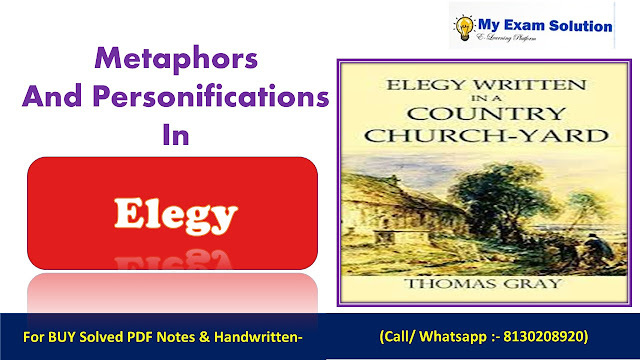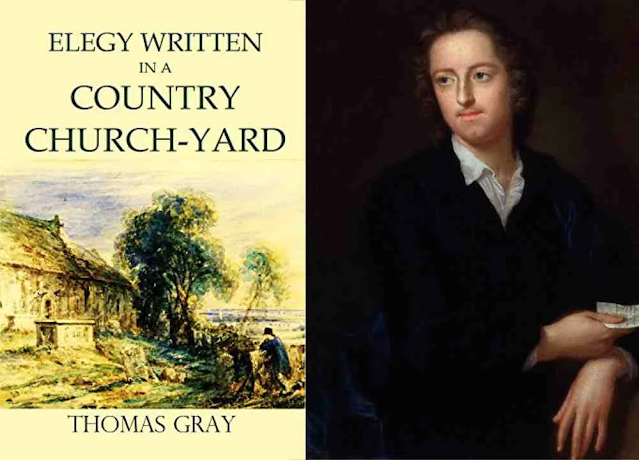Discuss the metaphors and personifications used in the Elegy
Thomas Gray's Elegy Written in a
Country Churchyard stands as a masterwork of poetry known for its elegant
articulation of universal themes like death, time passing, and the tranquil
lives of regular people. The deft use of personifications and analogies by Gray
lies at the core of the elegy's profundity and beauty.
Metaphors in Elegy Written in a Country Churchyard:
The Paths of Glory (Line 36):
Metaphor: In the line "The paths of glory lead but to the grave," Gray uses the metaphor of paths to represent life journeys and ambitions.
Discuss the metaphors and personifications used in the Elegy-The term "the grave" is a
metaphor for the end point, suggesting that all roads, no matter how glorious,
eventually lead to death. The word "glory" connotes goals and
accomplishments.
Far From the Madding Crowd" (Line 40):
Metaphor: Gray employs the metaphor
"far from the madding crowd" to describe the tranquil setting of the
churchyard. The phrase "the grave" refers to the destination,
implying that all paths, no matter how magnificent, ultimately lead to death.
The term "glory" suggests objectives and successes.
The Rude Forefathers of the Hamlet (Line 55):
Metaphor: The phrase "rude
forefathers" metaphorically refers to the simple and unsophisticated
ancestors of the hamlet. The word "rude" conveys a sense of
simplicity and lack of refinement, painting a picture of a humble community
with uncomplicated lives.
The Paths of Glory, Ne'er to Be Forgot (Line 78):
Metaphor: Similar to the earlier use of "paths of glory," this line reinforces the metaphor, suggesting that the memory of individuals' lives and deeds is a form of enduring glory.
Discuss the metaphors and personifications used in the Elegy-The metaphorical paths become a legacy that lingers in the
collective memory.
The Morn of Toil (Line 79):
Metaphor: The phrase "morn of
toil" metaphorically represents the beginning or dawn of labor and hard
work. This metaphorical morning signifies the start of a life marked by labor
and effort, contributing to the overall theme of the commonality of human
experience.
Some Village-Hampden, That, with dauntless Breast (Line 89):
Metaphor: The metaphorical
"village-Hampden" refers to an individual in the hamlet possessing
the qualities of John Hampden, a figure known for his resistance against unjust
taxation. Here, it metaphorically represents someone in the village with a
courageous and defiant spirit.
Also Read-
- Discuss Some Critical Assumptions About The Epitaph Of The Elegy
- Write A Critical Summary Of Gulliver’s Travels Book IV
- Critically Analyse The Major Themes In The Way Of The World
The Bigot's Martyrdom (Line 93):
Metaphor: In this line, Gray uses
the metaphor of "The Bigot's Martyrdom" to convey the idea of an
individual suffering for deeply held beliefs. The word "bigot"
suggests narrow-mindedness or intolerance, and the metaphor emphasizes the
sacrifice made for steadfast convictions.
The Short and Simple Annals of the Poor (Line 105):
Metaphor: The metaphorical
"short and simple annals" refers to the brief and uncomplicated
records of the lives of the poor. This metaphor underscores the unadorned
nature of their life stories, highlighting the contrast with the grander annals
of the wealthy and powerful.
Personifications in Elegy Written in a Country Churchyard:
Now fades the glimmering landscape
on the sight (Line 13):
Personification: The phrase
"fades the glimmering landscape" personifies the landscape, giving it
the ability to fade from view. This personification contributes to the
melancholic tone, as if the landscape itself is succumbing to the advancing
night.
The lowing herd wind slowly o'er
the lea (Line 17):
Personification: The "lowing
herd" is personified as it "winds slowly o'er the lea." The use
of the word "winds" gives the impression that the herd is moving in a
deliberate and almost contemplative manner, contributing to the overall
pastoral and reflective atmosphere of the elegy.
The curfew tolls the knell of
parting day (Line 1):
Personification: The
personification of the curfew tolling the "knell of parting day"
imbues the curfew with the human-like ability to toll and mark the end of the
day. This personification sets the scene for the elegy's contemplation of
life's transience.
BUY PDF & Book
WhatsApp - 8130208920
Save that, from yonder ivy-mantled
tower (Line 19):
Personification: The phrase
"yonder ivy-mantled tower" personifies the tower by giving it the
ability to be "mantled" with ivy. This personification adds a touch
of vivid imagery, portraying the tower as if adorned with a garment of ivy.
The swallow twittering from the
straw-built shed (Line 21):
Personification: The "swallow
twittering" is personified, suggesting an animated and communicative
nature. This personification contributes to the overall sense of life and
activity in the rural setting described by Gray.
The Ploughman homeward plods his
weary way (Line 23):
Personification: The phrase
"homeward plods his weary way" personifies the ploughman, attributing
a sense of weariness to his journey home. This personification humanizes the
figure, emphasizing the toil and exhaustion associated with his labor.
Slow through the church-way path we
saw him borne (Line 93):
Personification: The phrase
"Slow through the church-way path we saw him borne" personifies the
church-way path, endowing it with the ability to witness and participate in the
somber procession. This personification enhances the elegy's portrayal of the
churchyard as a witness to the passage of lives.
Each in his narrow cell forever
laid (Line 103):
Personification: The phrase
"Each in his narrow cell forever laid" personifies the narrow cell as
a final resting place, giving it a sense of permanence and eternity. This personification
contributes to the solemnity of the elegy's reflections on mortality.
Conclusion
Readers are drawn in by Thomas
Gray's "Elegy Written in a Country Churchyard" because of its
in-depth examination of life, death, and the modest stories of everyday people.
The elegy's emotional power is enhanced by the skillful use of personifications
and metaphors, which help to build a moving portrait of the human condition.
Gray crafts a tapestry of imagery
that transcends the particulars of time and place with personifications like
"paths of glory" and metaphors like "swallow twittering,"
encouraging readers to consider the universal features of mortality and the
enduring legacy of the common man.
The elegy is elevated from a simple
contemplation on death to a timeless meditation on the universal issues that
unite all people by the use of metaphorical language.
IMPORTANT QUESTIONS
Q 1: How does metaphoric language contribute to the depth of Elegy Written in a Country Churchyard?
A: Metaphoric language in the elegy
enriches its meaning by offering symbolic representations of universal themes
such as life, death, and the passage of time. Metaphors like "paths of
glory" and "short and simple annals" add layers of
interpretation, inviting readers to delve into the profound and timeless
aspects of the human condition.
Q 2: What is the significance of personification in the elegy?
A: Personification breathes life
into both natural and man-made elements in the poem, creating a vivid and emotive
landscape. The "curfew tolling" and the "ploughman homeward
plods" become more than descriptions; they take on human-like qualities,
evoking a sense of shared experience and emotion. This technique enhances the
elegy's power to connect with readers on an emotional level.
Q 3: How do metaphors contribute to the theme of mortality in
the elegy?
A: Metaphors such as "the
paths of glory lead but to the grave" and "each in his narrow cell
forever laid" underscore the inevitability of mortality. By comparing life's
journeys to paths and graves to narrow cells, the metaphors emphasize the
inescapable and universal nature of death, contributing to the elegy's
contemplation of the transience of human existence.
Q 4: What is the role of personification in portraying the
rural setting of the
elegy?
A: Personification adds a dynamic
quality to the rural setting, infusing elements like the "lowing
herd" and the "swallow twittering" with life. This technique not
only paints a picturesque scene but also invites readers to envision the
harmonious coexistence of nature and human life. Personification contributes to
the elegy's pastoral and reflective atmosphere.
Q 5: How does the figurative language in the elegy contribute
to its enduring appeal?
A: The figurative language, including
metaphors and personifications, transcends the specific historical context of
the elegy, giving it a timeless quality. The evocative imagery and symbolic
representations allow readers from various periods to connect with the
universal themes explored in the poem, ensuring its enduring appeal and
relevance.








0 comments:
Note: Only a member of this blog may post a comment.